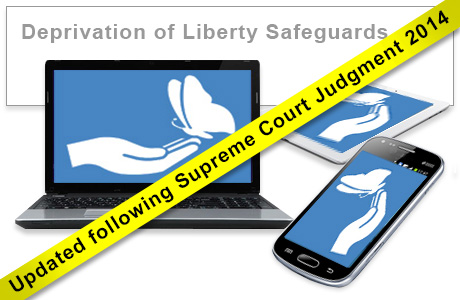deprivation-liberty-safeguards-f
Deprivation of Liberty Safeguards (F): e-learning training course

Removing an individual's liberty is a serious matter. As a practitioner in health and social care, you need to know what constitutes deprivation of liberty, what to do and who is responsible for making decisions.
This e-learning course introduces the key principles contained in the Deprivation of Liberty Code of Practice. It also provides guidance as to how the Supreme Court’s Judgment on the Deprivation of Liberty Safeguards, handed down in March 2014, should be interpreted and applied by care providers. It describes the fundamental distinction between detaining someone lawfully in their best interests and unlawfully depriving someone of their liberty on the other. A case study is included which requires students to make decisions based on a particular set of circumstances.
Unit Titles and Descriptions
Unit 1 - How to Use the Course
Unit 2 - Deprivation of Liberty Safeguards
This unit introduces the key principles contained in the Deprivation of Liberty Safeguards (DOLS) Code of Practice and helps learners to apply them in their work. It also introduces the Supreme Court’s judgment on the safeguards, published in March 2014, and explores how this affects care providers.
The unit explains why depriving someone of their liberty is a very serious issue and helps learners to understand the key distinction between detaining someone lawfully in their best interests on the one hand, and unlawfully depriving someone of their liberty on the other. The unit concludes by summarising what the safeguards are, why they were introduced and what the responsibilities of the relevant authorities are.
Unit 3- The DOLS Case Study
This unit can be used in three main ways:
- as the basis for staff training sessions
- for individual learning and continuing professional development
- as a day-to-day reference for staff.
The unit contains a scenario that requires learners to make two decisions involving the Deprivation of Liberty Safeguards. Learners are asked to read the descriptions and see what all the characters have to say by clicking on them. Once they have obtained all the relevant information, learners are asked to decide on the course of action they should take.
Learning Objectives: at the end of the course, students will be able to:
- Give reasons why people sometimes need to be deprived of their liberty
- Distinguish between lawful detention and unlawful deprivation of liberty
- Refer to examples of case law
- Follow the correct procedure if they suspect someone is being unlawfully deprived of their liberty
- Describe good practice which can reduce the risk of unlawful deprivation of liberty
- List the assessments required in order to authorise deprivation of liberty
- Describe the process for authorising deprivation of liberty
Topics include:
- The safeguards and why they were introduced
- Who is covered by the safeguards
- The significance of the Supreme Court’s judgment on the safeguards in March 2014
- Applying the Code of Practice
- What constitutes lawful and unlawful deprivation of liberty
- Managing Authorities and supervisory bodies
- Processes for Assessment and Authorisation
- The role of the court of protection
- Key points for care homes and hospitals
- What happens when someone is unlawfully deprived of their liberty.
Copyright Notice | Terms and Conditions | Privacy Statement | Disclaimer |
Copyright © 2006 - 2024 Embrace Learning Ltd.